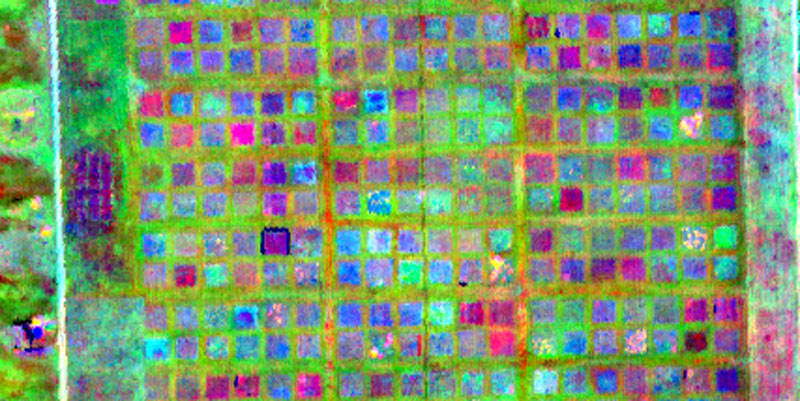
Hyperspectral airborne imaging of a field at the U of M's Cedar Creek Ecosystem Science Reserve.
With the goal of revolutionizing how the world understands the causes and consequences of biodiversity loss, the University of Minnesota has been awarded a $12 million grant by the National Science Foundation (NSF) to establish the Biology Integration Institute (BII). Based on the Twin Cities campus, it is conducted in partnership with researchers at the University of Wisconsin-Madison (UW-Madison).
Understanding biodiversity loss
The BII is the only research institute of its kind aimed at using spectral biology to create a greater understanding of plant and vegetation biodiversity from the genome to the global scale. Spectral biology uses the way light interacts with matter — in this case, plants — to reveal information about their chemistry, structure and function.
“We aim to uncover how the biological variation within and among species across the tree of life — detected in vegetation with hyperspectral sensors from handheld instruments, aircraft and satellites using a common currency of photons reflected from the sun — influences ecosystem and biosphere dynamics,” said Jeannine Cavender-Bares, BII director and professor in the U of M’s College of Biological Sciences (CBS). “Our ability to do this will be key to not only understanding biodiversity now, but providing the ability to track biodiversity loss in real-time around the globe.”
The institute will take advantage of NSF’s National Ecological Observatory Network (NEON), with researchers seeking to advance the ability to track the causes and consequences of biodiversity loss globally through spectral imaging. The institute will inform analysis from NASA’s global Surface Biology and Geology satellite mission, which will focus in part in creating a baseline measurement of global biodiversity. UW-Madison Professor and Institute co-director Philip Townsend has been involved in advancing the satellite, which is set to launch around 2027, toward the goal of measuring and monitoring vegetation chemistry and physiology.
The BII will incorporate spectral data into predictive models that advance theory on how life’s variation influences the Earth system in an era of rapid global change. It takes advantage of ongoing global change experiments led by Peter Reich, a professor at the U of M’s College of Food, Agricultural and Natural Resource Sciences and an Institute co-director.
Diversity in agricultural crops
CBS Associate Professor Ya Yang will expand her work in genomics as a BII co-principal investigator by examining linkages between genomes and spectral reflectance, which has implications for agricultural crops and its resistance to pathogens.
“By dissecting the connections among gene sequences, biochemistry, ecology, evolution and remote sensing data, we will be able to use remote sensing data to gather information on plant diversity and their physiological status in places that are hard to get to and in resolution that is never before possible,” said Yang.
Training future biologists
As researchers at the BII work to develop new methods aimed at understanding biodiversity, part of the Institute’s core mission is the recruitment of future integrative biologists who bring perspectives from across the sciences to better understand the interactions of plants and other organisms that inhabit the planet.
The BII aims to recruit non-traditional and underrepresented peoples in biology for mentoring and training opportunities, which include summer training workshops and a winter symposium, as well as experiences with the Global Change and Biodiversity Research Priority Program at the University of Zurich and the Canadian Airborne Biodiversity Observatory.
The Institute will work to foster curiosity in young scientists by working with K-12 students and Indigenous communities through long-term mentoring programs currently under development within the UMN Office of Equity and Diversity, Market Science modules, Minute Earth videos, and partnerships with the Bell Museum, Cedar Creek Ecosystem Science Reserve and Wisconsin Tribal Conservation Advisory Council. —Caitlin Hurley